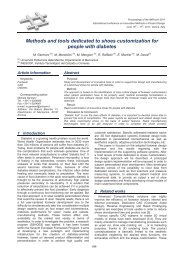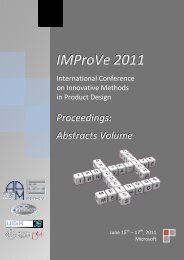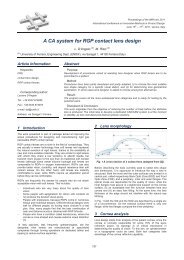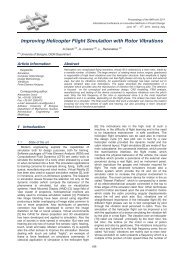IMProVe 2011 - Proceedings
IMProVe 2011 - Proceedings
IMProVe 2011 - Proceedings
You also want an ePaper? Increase the reach of your titles
YUMPU automatically turns print PDFs into web optimized ePapers that Google loves.
Design Methods and Applications<br />
campaign has been carried out to acquire vibration data over helicopters. The paper<br />
describes the implementation of a simulator which provides also the reproduction of<br />
vibration felt in flight by pilot. The attention is focused on the conceptual and preliminary<br />
design, CAD modelling, FEM analysis, manufacturing and testing of the device conceived<br />
to reproduce vibrations over the pilot’s seat. Only the first frequency of the rotor is<br />
reproduced since it is the most important excitations and it is variable, depending on the<br />
flight phase. The shaker has been built and installed on a simulator. The final result shows<br />
that such a simulator can improve the realism involving not only the senses of sight and<br />
hearing, but also providing a more “physical” feedback due to vibrations perception.<br />
Keywords: Simulation, Computer Aided Design, Design Methodology, Vibrations, Finite<br />
Element Analysis.<br />
Corresponding Author: Alessandro Ceruti<br />
Tel.:+39 051 2093452<br />
Fax.:+39 051 2093412<br />
e-mail: alessandro.ceruti@unibo.it<br />
Address: University of Bologna, Department of Mechanical, Nuclear, Aeronautical Engineering and<br />
Metallurgy.<br />
Optimization by Particle Swarm Algorithms<br />
of an UAV performed by Hot Wire Cutting Techniques<br />
June 15 th – 17 th , <strong>2011</strong>, Venice, Italy<br />
A. Ceruti (a), G. Caligiana (a), F. Persiani (a)<br />
(a) University of Bologna, DIEM Department<br />
Abstract:<br />
This paper describes an original application of unconventional optimization techniques by<br />
Particle Swarm Algorithms. An Unmanned Aerial Vehicle performed by Hot Wire Cutting is<br />
designed for a typical civil mission defining geometry and aerodynamics with a Particle<br />
Swarm Algorithm. The tailless configuration of the vehicle requires an accurate design to<br />
gain the satisfaction of all the requirements and to obtain a low cost solution. Only an<br />
unconventional technique can be applied because of the high non linearity of the problem<br />
and the high number of parameters to be defined. A first preliminary series of tests have<br />
been carried out to define the best values for inertia and acceleration coefficients of the<br />
Particle Swarm algorithm; in the following the algorithm results have been compared with<br />
those obtained by other two techniques like Genetic Algorithms and Monte Carlo<br />
Simulations. The result of this study shows how the Rapid Prototyping techniques can be<br />
applied to the performing of small lots of UAV: the required optimal design is gained<br />
applying the Particle Swarm Algorithm. The conclusion of this work confirms the suitability<br />
of non conventional optimization methods to non linear problems: Genetic Algorithms<br />
and Particle Swarm optimization provide similar results in term of fitness maximization,<br />
while Monte Carlo algorithm presents a lower efficiency. The Particle Swarm and Monte<br />
108<br />
<strong>IMProVe</strong> <strong>2011</strong> - <strong>Proceedings</strong>










